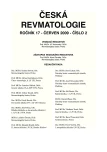The impact of biological modification of the surface of selected implant materials on the proliferation and synthetic activity of bone cells. In vitro study
Authors:
V. Pešáková 1; D. Kubies 2; T. Riedel 2; E. Třesohlavá 2; L. Himmlová 3
Authors‘ workplace:
Revmatologický ústav, Praha
1; Ústav makromolekulární chemie AVČR, Praha
2; Výzkumný ústav stomatologický VFN a 1. LF, Praha
3
Published in:
Čes. Revmatol., 17, 2009, No. 2, p. 84-90.
Category:
Original Papers
Overview
Aim of the study:
To study the impact of surface properties of selected implant materials on adherence of some blood components (plasma, serum), and the impact of these proteins, adsorbed on the implant surface, on the adhesion and synthetic activity of cultured osteoblasts using in vitro experiments.
Methods:
In selected materials such as etched titanium (Ti-Etch), plasma-sprayed titanium (Ti-PlaSpray), titanium with hydroxyapatite layer (Ti-HA), and carbon composite (C/C), the physiochemical parameters were determined (roughness, wettability, and free surface energy). Tissue culture polystyrene (TCPS) was used as a control. Biological modification of materials was performed by overlaying of one of two selected blood components – plasma or serum. Osteoblasts were cultured on materials without overlay, as well as materials with biological modification, and consequently, the proliferation of osteoblasts was evaluated due to the mitochondrial oxidation activity of monolayer (MTT assay). In the obtained culture medium, the activity of osteoblasts was determined as the level of bone alkaline phosphatase (BAP) and the production of inflammatory cytokines (TNF-α, IL-8) using enzyme-linked immunosorbent assay (ELISA).
Results:
High roughness of implants affected the increased proliferation in titanium materials (Ti-PlaSpray). A decreased proliferation of C/C is attributed to almost zero value of polar component of surface energy. Overlaying of materials by activated plasma (fibrin network) led to formation of unified surface in terms of both proliferation and synthetic activity. However, overlaying of implants by serum (albumin) did not have the anticipated stimulatory effect on osteoblasts.
Conclusion:
Overalying of selected implant materials by activated plasma (i.e. fibrin network) leads to formation of a surface with required balance between the proliferation rate and synthetic activity of osteoblasts as a model of organisms’s immune response to an applied implant.
Key words:
implant materials, surface properties, serum, plasma, proliferation, synthetic activity, osteoblasts, physiochemical parameters, cytokines
Sources
1. Groth T, Altankov G. Cell-surface interactions and the tissue compatibility of biomaterials. New Biomedical Materials, Haris P.I. and Chapman D. (Eds.) IOS Press, 199; 12–23.
2. Puleo DA, Nanci A. Understanding and controlling the bone-implant interface. Biomaterials 1999; 20: 2311–21.
3. ISO 10993–5: Biological evaluation of medical device.
4. Park JY, Gemmell CH, Davies JE. Platelet interactions with titanium: modulation of platelet activity by surface topography. Biomaterials 2001; 22: 2671–77.
5. Jones MI, McColl JR, Grant DM, Parker KG, Parker TL. Protein adsorption and platelet attachment and activation, on TiN, TiC; 52: 413–21.
6. Pešáková V, Smetana K Jr, Balík K, Hruška J, Petrtýl M, Hulejová H, Adam M. Biological and biochemical properties of the carbon composite and polyethylene implant materials. J Mater Sci: Mater Med 2003; 14: 531–37.
7. Laughton C. Quantification of attached cells in microtiter plates based on Coomassie Brilliant blue G-250. Staining of total cellular protein. Anal Biochemistry 1984; 140: 417–23.
8. Mosmann T. Rapid colorimetric assay for cell proliferation and survival application to proliferation and cytotoxicity assays. J Immun Methods 1983; 65: 55–61.
9. Quirynen M, Bollen C.M.L. The influence of surface roughness and surface free energy on supra- and subgingival plaque formation in man. A review of the literature. J Clin Periodontol 1995; 22: 1–20.
10. Milleding P, Gerdes S, Holmberg K, Karlsson S. Surface energy of noncorroded and corroded dental ceramic materials before and after contact with salivary proteins. Eur J Oral Sci 1999; 107: 384–392.
11. Groth T, Altankov G, Klosz K. Adhesion of human peripheral blood lymphocytes is dependent on surface wettability and protein preadsorption. Biomaterials 1994; 15: 423–28
12. Pesakova V, Kubies D, Hulejova H, Himmlova L. The influence of implant surface properties on cell adhesion and proliferation. J Mater Sci: Mater Med 2007; 18: 465–73.
13. Price C.P. Multiple forms of human serum alkaline phosphatase: Detection and quantitation. Ann Clin Biochem 1993; 30: 355–72.
14. Nanes M.S. Tumor necrosis factor : molecular and cellular mechanisms in skeletal pathology. Gene 2003; 321: 1–15.
15. Fritz EA, Glant TT, Vermes C, Jacobs JJ, Roebuck KA. Titanium particles induce the immediate early stress responsive chemokines IL-8 and MCP-1 in osteoblasts. J Orthop Res 2002; 20: 490–98.
Labels
Dermatology & STDs Paediatric rheumatology RheumatologyArticle was published in
Czech Rheumatology

2009 Issue 2
Most read in this issue
- HLA-Cw*0602 is a predisposing allele to develop psoriatic arthritis
- Limited significance of procalcitonin in differentiation between sepsis and flare of a rheumatic disease
- Secondary immunodeficiency with infectious complications following immunosuppressive therapy in a female patient with systemic lupus erythematosus
- Utilization of health care and the costs for patients with rheumatoid arthritis treated with TNF-α inhibitors in the Czech Republic
